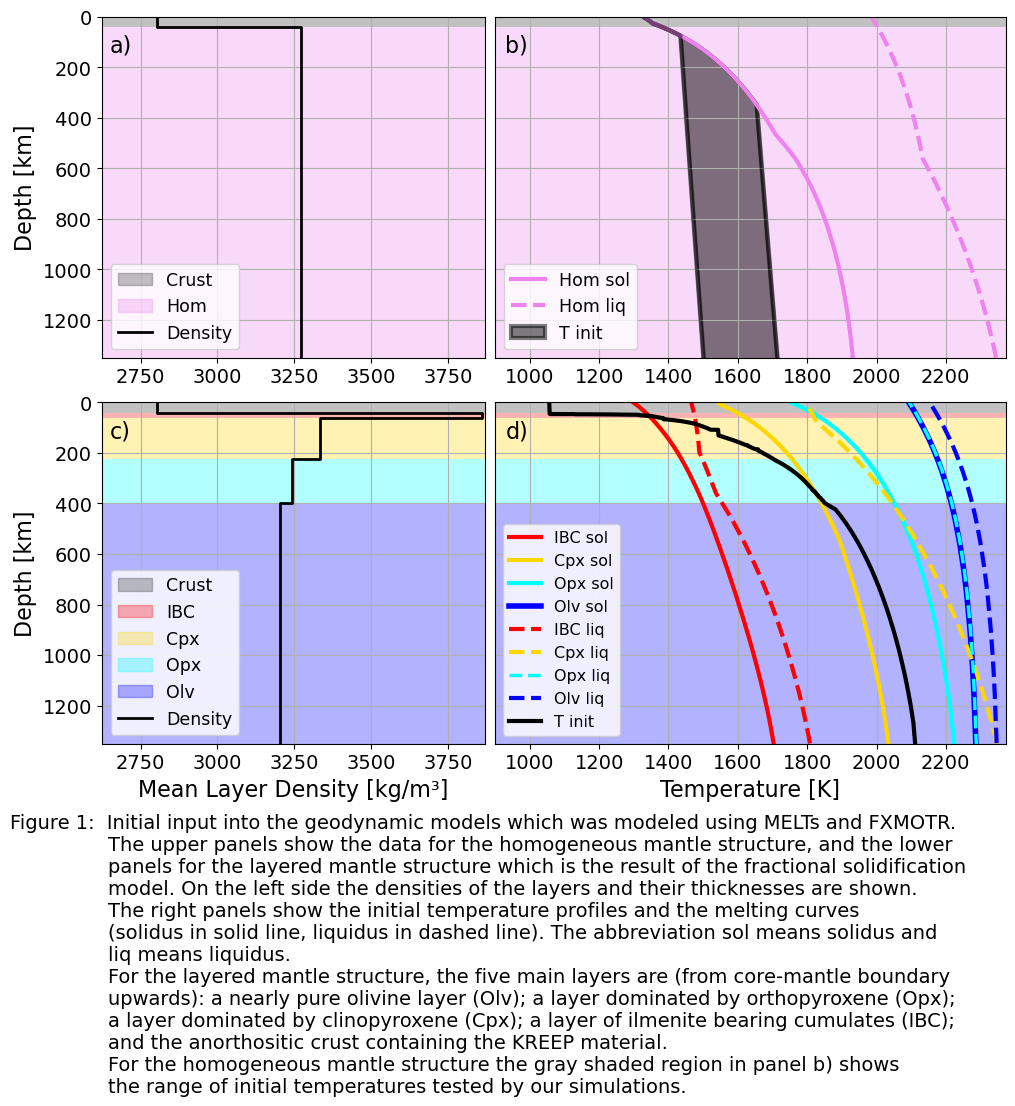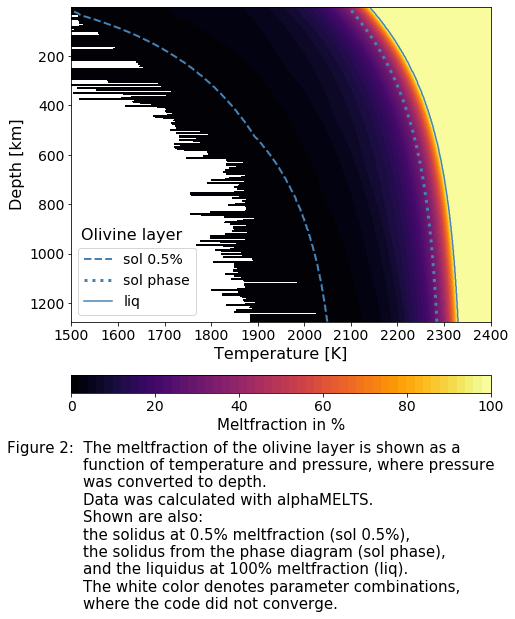Moons crust evolution: combining petrological with geodynamical models
- DLR, Institute of Planetary Research, Berlin, Germany (irene.bernt@dlr.de)
Introduction
After the formation of the Moon its surface was likely covered by a global lunar magma ocean (LMO). It is typically assumed that this LMO crystallized via bottom-up fractional solidification, where crystallized material accumulated at the bottom of the LMO. This leads to a layered mantle structure, where the early cumulates are dominated by olivine, then pyroxenes, and after about 60-70% of LMO crystallization plagioclase forms, which has a lower density and floats to the surface to build the crust. At the end of the solidification, the heavy elements such as iron and titanium crystallize, as well as the KREEP components and the heat-producing elements. As the density of the solidified material increases towards the surface, the mantle is prone to overturn. During and following the overturn, mantle material melts where the temperature exceeds its solidus. These melts rise to the surface and form the secondary crust, i.e., Mg-suite and mare basalts.
In this study, we investigate the formation of the secondary crust components and use their amount and timing of formation as constraints in our simulations. The amount of Mg-suite rocks is estimated to be 6-30% (Prissel et al. 2023, Warren & Kallemeyn 1993) and the amount of mare basalts to be 1-2% (Broquet & Andrews-Hanna 2024). The timing and duration of the Mg-suite rocks dated so far is very concise with 4348±25 Ma ago (Prissel et al. 2023) compared to the longstanding activity of the mare basalts between 3.9 – 1.2 Ga (Hiesinger et al. 2011).
Previous studies
In thermochemical evolution models studying the secondary crust formation, a common assumption for the structure of the Moon after LMO solidification is a homogeneous, peridotitic mantle and an anorthositic crust, sometimes with a layer of ilmenite bearing cumulates (IBC) beneath the crust. (e.g., Ziethe et al. 2009; Laneuville et al. 2013, 2018; Yu et al. 2019). Initially, after crystallization of the LMO, the temperature is typically set to the solidus temperature. These studies show longstanding volcanic activity also as a consequence of an insulating crust but generally result in far too high amounts of secondary crust - as also confirmed in our work. Recently, Prissel et al. (2023) have studied the formation of Mg-suite and find that the rapid rise and melting of the olivine cumulates due to mantle overturn can explain their formation shortly after the crystallization of the LMO. Their model, however, does not consider mare basalt formation and assumes the initial temperature to be equal to the solidus temperature after LMO solidification - as the previous models described above.
Petrological Model
In our petrological model (Schwinger & Breuer 2022), we calculate a layered mantle structure assuming fractional solidification of a global magma ocean of 1350 km. As initial composition of the lunar magma ocean we consider the composition of O'Neill (1991) with 10 wt% FeO. The complex stratification has been approximated by five main layers (Fig 1c). For each of these layers the density, the thickness, and for mantle layers also the solidus and liquidus are calculated.

We investigate different approaches to get a realistic solidus, using MELTS and comparing the results to the phase diagrams (Fig. 2). Within the cpx-layer the density and the melting temperatures change substantially. Therefore, we additionally investigate a mantle structure, where the cpx layer is further divided in three sublayers (not shown in Fig. 1). We consider the change in density and solidus due to secondary melting for each mantle layer. Furthermore, the solidification model provides the crystallization temperature that is used as initial temperature profile for the geodynamic models.
Geodynamic Model
For the thermochemical evolution models, we use the mantle convection code GAIA (Hüttig et al., 2013). In addition to the layered initial lunar mantle structure, we consider also a homogeneous mantle structure with peridotitic composition for comparison. We employ an Arrhenius law to calculate the depth- and temperature-dependent viscosity, and we consider core cooling and radioactive decay. The material of the different layers mixes due to solid-state convection. We employ a particle-in-cell method (Plesa et al., 2013) to track the mixing, where the tracer particles carry information such as the composition, the density, the mantle depletion, and the melting temperatures of the material. We consider the influence of latent heat consumption during melting and the changes in residual materials due to secondary melting. The amount of melt is calculated using a linear interpolation between the solidus and the liquidus.

Results and Discussion
The results show that both the rapid formation of the Mg-suite rocks and the mare basalts, with ages as young as 1-2 Ga ago, are difficult to achieve with the current models. Neither a homogeneous mantle with peridotitic composition (too much crust is produced or too late in the evolution) nor a layered mantle due to fractional crystallization (olivine cumulates as a reservoir for the Mg-suite cannot be molten and crust formation ends too rapidly) can explain the observations. In the models with a layered mantle, the main reason is the difference between the crystallization temperature and the melting temperatures as a consequence of the fractional crystallization. Thus, our results do not support the findings of Prissel et al. (2023) who suggest that the formation of the Mg-suite is caused by the lunar global overturn of the fractionated LMO. In these models, however, the authors assume that the crystallization temperature is equal to the solidus temperature – which is not consistent to the petrological model (cf. Fig. 1).
To explain the observed volcanic history, we conclude that pure fractional crystallization of the LMO seems unlikely. We discuss possible ways to produce the Mg-suite and prolong the formation of mare basalts, including batch crystallization of the deep magma ocean, the onset of mantle convection already during solidification of the LMO, the presence of a primitive mantle layer beneath the crystallized magma ocean, but also the influence of water and melt in the retention.
Acknowledgements
I.B. and S.S. were supported by DFG SFB-TRR170, (subprojects C4 and A5).
How to cite: Bernt, I., Schwinger, S., Plesa, A.-C., and Breuer, D.: Moons crust evolution: combining petrological with geodynamical models, Europlanet Science Congress 2024, Berlin, Germany, 8–13 Sep 2024, EPSC2024-1242, https://doi.org/10.5194/epsc2024-1242, 2024.